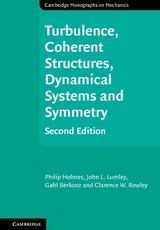
Turbulence, Coherent Structures, Dynamical Systems and Symmetry
Seiten
1996
Cambridge University Press (Verlag)
978-0-521-55142-7 (ISBN)
Cambridge University Press (Verlag)
978-0-521-55142-7 (ISBN)
- Titel erscheint in neuer Auflage
- Artikel merken
Zu diesem Artikel existiert eine Nachauflage
This book offers a new approach to the modelling and analysis of turbulent flows dominated by coherent structures. Using techniques from probability theory and nonlinear dynamics, the authors show how the governing nonlinear equations of fluid mechanics may be reduced to simpler models which provide understanding of the basic mechanisms of turbulence generation.
For turbulent flows at relatively low speeds there exists an excellent mathematical model in the incompressible Navier–Stokes equations. Why then is the 'problem of turbulence' so difficult? One reason is that these nonlinear partial differential equations appear to be insoluble, except through numerical simulations, which offer useful approximations but little direct understanding. Three recent developments offer new hope. First, the discovery by experimentalists of coherent structures in certain turbulent flows. Secondly, the suggestion that strange attractors and other ideas from finite-dimensional dynamical systems theory might play a role in the analysis of the governing equations. And, finally, the introduction of the Karhunen-Loève or proper orthogonal decomposition. This book introduces these developments and describes how they may be combined to create low-dimensional models of turbulence, resolving only the coherent structures. This book will interest engineers, especially in the aerospace, chemical, civil, environmental and geophysical areas, as well as physicists and applied mathematicians concerned with turbulence.
For turbulent flows at relatively low speeds there exists an excellent mathematical model in the incompressible Navier–Stokes equations. Why then is the 'problem of turbulence' so difficult? One reason is that these nonlinear partial differential equations appear to be insoluble, except through numerical simulations, which offer useful approximations but little direct understanding. Three recent developments offer new hope. First, the discovery by experimentalists of coherent structures in certain turbulent flows. Secondly, the suggestion that strange attractors and other ideas from finite-dimensional dynamical systems theory might play a role in the analysis of the governing equations. And, finally, the introduction of the Karhunen-Loève or proper orthogonal decomposition. This book introduces these developments and describes how they may be combined to create low-dimensional models of turbulence, resolving only the coherent structures. This book will interest engineers, especially in the aerospace, chemical, civil, environmental and geophysical areas, as well as physicists and applied mathematicians concerned with turbulence.
Preface; Part I. Turbulence: 1. Introduction; 2. Coherent structures; 3. Proper orthogonal decomposition; 4. Galerkin projection; Part II. Dynamical Systems: 5. Qualitative theory; 6. Symmetry; 7. One-dimensional 'turbulence'; 8. Randomly perturbed systems; Part III. 9. Low-dimensional Models: 10. Behaviour of the models; Part IV. Other Applications and Related Work: 11. Some other fluid problems; 12. Review: prospects for rigor; Bibliography.
| Erscheint lt. Verlag | 10.10.1996 |
|---|---|
| Reihe/Serie | Cambridge Monographs on Mechanics |
| Zusatzinfo | 13 Halftones, unspecified; 80 Line drawings, unspecified |
| Verlagsort | Cambridge |
| Sprache | englisch |
| Maße | 158 x 236 mm |
| Gewicht | 856 g |
| Themenwelt | Naturwissenschaften ► Physik / Astronomie ► Mechanik |
| Naturwissenschaften ► Physik / Astronomie ► Strömungsmechanik | |
| ISBN-10 | 0-521-55142-0 / 0521551420 |
| ISBN-13 | 978-0-521-55142-7 / 9780521551427 |
| Zustand | Neuware |
| Informationen gemäß Produktsicherheitsverordnung (GPSR) | |
| Haben Sie eine Frage zum Produkt? |
Mehr entdecken
aus dem Bereich
aus dem Bereich
Statik - Kinematik - Kinetik - Schwingungen - Festigkeitslehre
Buch | Hardcover (2021)
Hanser, Carl (Verlag)
29,99 €



